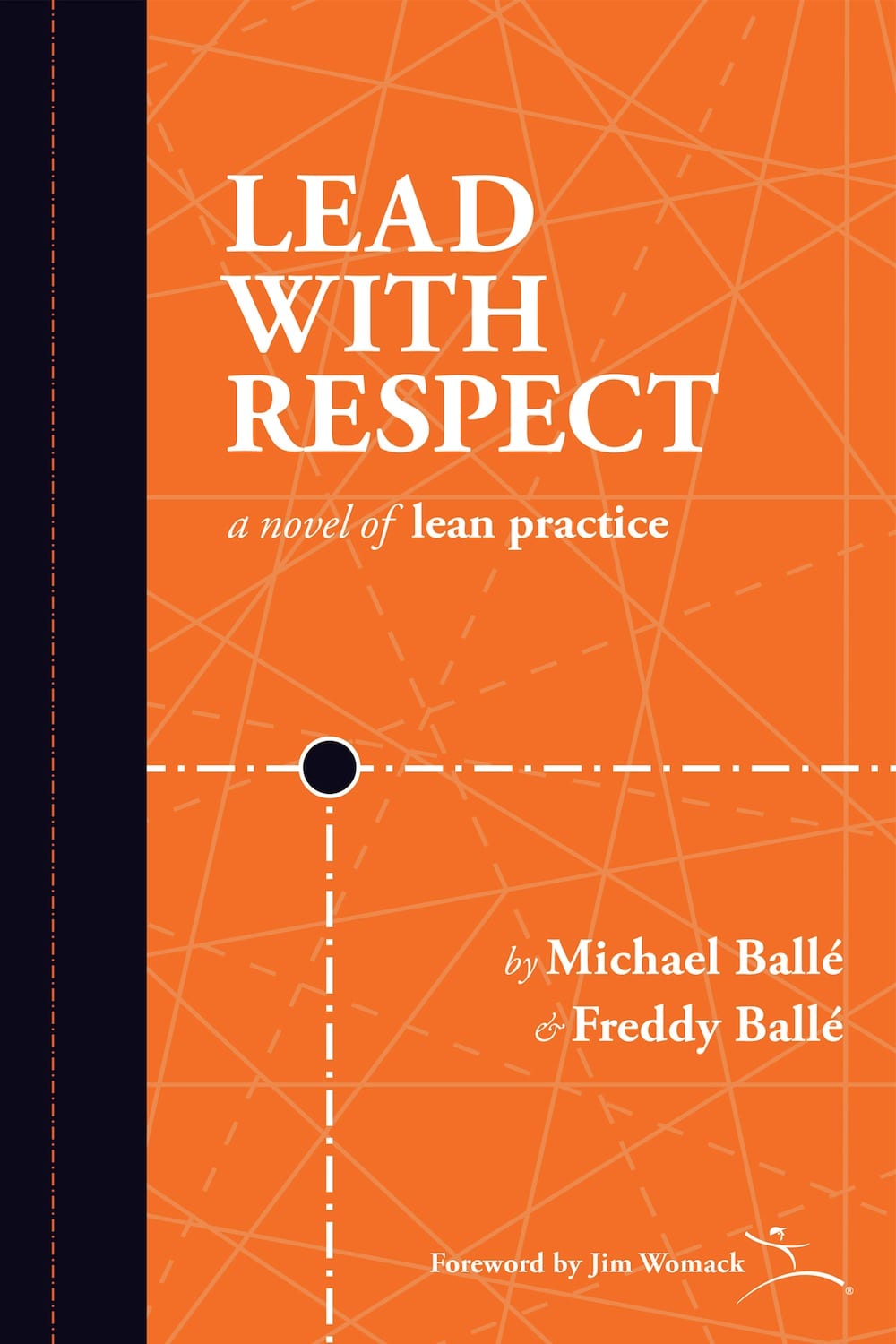
Why respect for people and lean are the only way forward
FEATURE - Mission creep, silos and a disengaged workforce are some of the negative effects of traditional management. Michael Ballé offers an alternative based on the respect for people principle of lean thinking.
Words: Michael Ballé, executive coach, author and Co-founder of Institut Lean France
The mainstream approach to management is so deeply etched in our minds that we tend to find it completely natural. We commonly refer to this form of management as "command and control" (with its five elements of Plan, Organize, Staff, Direct, Control): in this acceptation, the role of a manager is to decide what to do and to plan how to get it done, then to organize things in a way that guarantees the best use of available resources, then to find the staff to execute the plan, tell them how to do the work and finally make sure everything goes according to plan.
As a corollary, modern managers have often tried to organize the direct and control aspects of the implementation as well, by creating entire departments whose only purpose is to make sure action plans are followed, results are reported and practices are audited.
Traditional management does get things done, eventually. No question about it. However, the approach has a number of major drawbacks: mission creep, silo politics, and employee disengagement.
First, there is a risk of losing sight of the customer-driven purpose. Mission creep occurs when the focus on output and optimization hides outcomes and the need for discernment. Things get done because things get done, and eventually no one is too sure of what the mission has become. Businesses, even small ones, lose sight of the fact that their purpose is to support their customers in achieving what they want, as opposed to making money by selling what they have in the inventory. Emphasis on optimizing resources inherently turns people's focus on internal structures and systems, and away from customers.
A very simple test of this is asking yourself how much time out of your own day is spent discussing how to best serve customers as opposed to worrying about how to make the organization work?
In tough times, many companies embark in cost-cutting efforts that will affect customers by reducing "unwanted" functionalities, shrinking product ranges or using cheaper materials. Instead, they should get their supply chain to work better, release cash from inventories, and reinvest it in increasing customer value.
Improving the flow, of course, would mean teamwork between departments, which rarely happens because of organizational silos.
Silos mean silo politics. Each department head solves his or her problem, as seen from the department's point of view. They can correctly plan, organize, staff, direct and control how they do their own work without having to worry about what other departments are doing in the company. As a result, interactions with other department heads tend to be limited to fighting for resources (there is never enough) and to finger pointing: "It's not my fault if things go wrong overall. I'm doing my part, I'm pulling my weight."
Coordination is such a common problem in command-and-control organizations that everyone now accepts it as unavoidable, and senior executives believe that, when it gets out of hand, the answer is re-organizing. Breaking barriers between departments is the key to accelerating the overall flow of work to better serve customers without carrying so much organizational dead weight, but this in turn hinges on employee engagement in solving problems across functional boundaries.
Unfortunately, command and control also creates disengagement.
Disengagement at work is becoming such a visible concern that it's finally starting to be recognized as a legitimate issue. A Gallup piece of research, for example, found that employee engagement is at an all time low, with only 30% of US employees showing up at work committed to deliver their best performance (the resulting loss of productivity for the US economy is in the $450 to $550 billion dollar range). A Harvard Business Review study shows that "while most leaders understand the importance of engagement, three-quarters of those surveyed said that most employees in their organizations are not highly engaged."
None of these problems are particularly mysterious or unknown to managers themselves. Indeed, the same 2013 HBR study draws a striking picture of current management thinking: among the factors most likely to bring success, a high level of employee engagement ranked third (scoring as much as "strong executive leadership" did) after a high level of customer service and effective communications.
The problem, of course, is that there is no way to get an engaged workforce using the mainstream management approach.
Lack of customer service, functional politics and employee disengagement are natural side effects of the daily practice of Plan, Organize, Staff, Direct, Control management. In other words, the more you plan, organize, staff, direct and control your employees, the more you personally contribute to their non-performance. Just face it.
There is an alternative.
A NEW FORM OF MANAGEMENT
The lead with respect model - made up of Go and See, Challenge, Listen, Teach, Support, Teamwork and Learn - is a radically different management practice, based on engaging people and showing them the direction forward rather than trying to do their thinking for them.

The basic premise of lead-with-respect management is that you have the organization you have, which you cannot change. Rather than drawing up an new plan to re-organize, you start by going and seeing how things really work in order to:
1. Share the challenges of the company with employees - show what questions need to be answered in order to better serve customers right now, and what larger issues are to be solved to better serve customers tomorrow. “Show” is the operative word here, because challenging is not about telling or planning, but about behaving. By asking questions about customer service, customer complaints, difficulties in understanding what customers want, the leader frames expectations for everyone everywhere in a clear, demonstrable way that doesn’t rely on speeches and mission statements, but on modeling behavior through direct involvement.
2. Listen hard to obstacles people face - unsurprisingly, when challenged to better serve internal and external customers, employees will explain why this or that is not happening. They’ll rarely tell you they don’t want to do it. Most of the time, they’ll explain why it can’t be done. Some of these obstacles are real (procedures or organizational systems often get in the way); some are just in people’s minds. Whether you consider one or the other, the fact is that people have encountered an obstacle. As a leader, you should neither condone nor dismiss the problem. Understanding does not mean agreeing, but acknowledging the obstacle and, instead of jumping to conclusions, asking people to reflect more deeply on it and to suggest a way to overcome it.
Then, rather than “staff” and bring in new teams, a leader takes the responsibility of training the people already in the organization and explaining to them that facing the company’s long-term challenges today might result in changes in roles and priorities tomorrow. Leaders have to work with their people and:
3. Teach new skills - in particular, train every middle manager to take responsibility for training their own direct reports. Facing challenges and working in a turbulent environment means honing old skills and learning new ones every day. The leader’s job is to make sure this happens daily, on the job, as part of regular work - lean offers many techniques to do so. Important skills to teach include learning to see the improvement potential in current activities, analyzing the current work method, coming up with new ideas and initiatives, trying them and seeing if they work.
4. Support learning efforts and initiatives - learning to change is hard and involves 1) mastering existing standards and 2) improving point by point to discover what needs to be changed. Seeking to improve creates the most basic human drive to learn new skills, but is something that needs to be carefully nurtured by management. Managers, therefore, need to learn to acknowledge people’s difficulties, keep them motivated in their improvement initiatives, give them space to experiment, and recognize their efforts. This means teaching middle managers to say “try” (and create the conditions for them to do so) rather than “no way.”
Direct and control are mostly about making sure action plans get executed within one’s department. As a middle manager, the idea is that if you correctly run your area, you are doing your job right and no one can blame you. In today’s fast and highly interconnected companies and markets, however, this is sheer nonsense. Silos are necessary because they’re the key to training and support, and because employees need some sort of professional affiliation within the business both for their own learning and for recognition. However, the work needs to flow seamlessly from one department to the next, from silo to silo, and this can only happen if department heads learn to work with one another on daily basis. In this sense:
5. Teamwork is a skill, which translates into knowing how to solve problems with colleagues across organizational borders. Rather than letting middle managers hunker down in fortress thinking in order to protect the stability of their department, a leader must continuously develop teamwork by getting department heads to focus together on addressing large-scale challenges by solving specific problems across functions. This means meeting regularly not to present on the state of a department (while every one else in the room checks their e-mail) but to solve cross-functional customer problems together, one by one, in order to develop stronger working relationships across the business.
6. Learn from improvement efforts: rather than controlling that plans and instructions have been properly implemented, leaders will discover the dynamic power of studying how their people solve problems. Measurement is essential to learning, not for reward-or-blame purposes, but to learn what works and what doesn’t. Or, more specifically, in which conditions new methods work and in which they don’t. Leaders must learn to recognize truly innovative ideas, no matter how unpromising in their early stages, and to protect them from the organizational status quo to let them blossom into full-fledged innovations.
Learning from point-by-point improvement effort has a rather large impact on organizational design: rather than restructuring or reorganizing, the business will adapt one change point at a time. This is often somewhat disturbing because it means letting go of the idea that 1) there is an optimized form of organization and 2) that we clearly know what that is. In seeking dynamic gains rather than static optimizations, leaders learn to let their organizations evolve (rather than destroying and reconstructing them), by managing changes one after the other. For every new specific change, leaders learn to recognize remaining issues and already think about the next one, to keep up the pace of the transformation.
Innovation is the name of the game – every management review offers its own suggestion on how to turn a company or department into “innovation engines.” This is missing the point that outcomes, whatever they might be, are the result of what people do every day. What you tolerate will continue to happen, just like the new skills that you practice relentlessly every day will eventually change the way the organization behaves. There is no way around this.
Every one agrees that improving the organization’s capability to innovate rests on customer focus, cross-functional collaboration and employee engagement. However, this is unlikely to happen until daily management behavior stops to actively discourage the attainment of these three elements.
The ability to innovate and keep up with a fast moving environment relies on building the capability to innovate within everyone, every day and everywhere. This requires a completely new approach to management. Lead with respect management is radical inasmuch as it opens a different door – as a practice, it is built mostly on attitude and a few visual tools. Acquiring it depends on one’s will to acquire it, not on long and arduous studies.
In other words, you become what you practice, and there is no better time to start than now. To quote the lead character in my latest novel Lead With Respect: “Next week is a new beginning. For that matter, tomorrow is a new beginning. Right now is a new beginning.”

PURCHASE YOUR COPY OF LEAD WITH RESPECT TODAY
US readers, click here
Dutch readers, click here
UK readers, click here
THE AUTHOR

Read more


WOMACK’S YOKOTEN – 5S seems to mean different things to different people. What’s common, however, is the difficulty to sustain it. The author offers a few tips.


CASE STUDY - Addressing failure cost and introducing a new quoting process are only two of the ways in which Dutch construction company Dura Vermeer is successfully achieving a lean transformation.


FEATURE – Looking back on the lean journeys he's seen firsthand, the author concludes that a true lean transformation occurs when you establish lines of mentoring to the Thinking People System.



THE LEAN BAKERY – In the last episode of our video series, we learn how 365 is using an impressive visual management system to manage the accounting and human resources functions.

